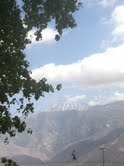 The humble and beautiful Agave deserti. Desert gardeners may await its bloom with anticipation at this time of year, but the Native Peoples of the deserts of Mexico and California depended on it for its delicious roasted “heart,” its tasty flowers, and for its seed, ground into flour.
The humble and beautiful Agave deserti. Desert gardeners may await its bloom with anticipation at this time of year, but the Native Peoples of the deserts of Mexico and California depended on it for its delicious roasted “heart,” its tasty flowers, and for its seed, ground into flour.
In return, traditional people practiced what anthropologists have come to call ethno-agronomy; the management of wild-plant populations. At least this is how Deborah Dozier, in a small booklet, Stalking the Wild Agave: A Food and Fiber Tradition, published by the Malki Museum Press of Banning, Calif., describes it. I tried to look it up, ethno-agronomy. I came across the words “cognized models” and ran the other way. To read these scientific papers and interpret them — well, not today.
But Gary Paul Nabhan, the Southwestern desert’s best known botanist, writes in Gathering the Desert that the peoples of the Southern California deserts cultivated agave, planting the “pups” known to all gardeners, over acres and acres.
The idea of tending a population of plants in the wild is thrilling. A lot better than seeing, by the side of the Ernie Maxwell Scenic Trail up in here in Idyllwild, a fat oval of over-bred, brazen-yellow daffodils. Someone carried the bulbs up to the trail a few years ago, and in a misguided burst of beautification-of-the-forest zeal, planted them.
The tiny and wonderful Malki Museum began in 1964, the first of the Native American museums in California to be founded by Native American people, Jane Penn, and the late (2012) Dr. Katherine Siva Saubel, who was an anthropologist of her people. Last weekend, on April 13, the annual agave roast was held. (Alas, I missed it, but I won’t next year.)
From the Museum’s website:
The Agave Harvest and Roast is an annual event sponsored by the Malki Museum. It is held on two consecutive Saturdays in mid- to late-April, when the Agave plants were traditionally gathered. The agave or amul was a basic food staple for the Cahuilla and Kumeyaay Indians of Southern California.
The harvested agave is brought back to the Malki Museum for the Agave Roast, held the following Saturday. The agave hearts are cooked in a traditional roasting pit and served with other customary Native foods.
What I did not expect at the Malki Museum was its ethnobotanical garden, Temalpakh, a “living illustration” of the book Temalpakh: Cahuilla Indian Knowledge and Usage of Plants by Dr. Siva Saubel and Lowell Bean. (This essential book, and the booklet mentioned above, which describes in detail methods of agave gathering and roasting, can be ordered from the Museum’s site, www.MalkiMuseum.org.)
Temalpakh means “of the earth”; the garden is beautifully tended and maintained by a grandson of Katherine Siva Saubel.
Here’s what the San Jacinto Mountains look like from that garden outside the Malki Museum:
Deborah Dozier’s booklet opens with a quote from an informant of Keith Basso, an anthropologist, who, as far as I’m concerned, walks on water. The following is, according to Dozier, quoting Basso, an excerpt from instructions by a Western Apache headman to his kin as they are about to leave before dawn to gather food.
You women who go out to gather acorns and walnuts, don’t go alone. Go in a party of three or four. Look after each other. If you get a mescal (agave) head ready to cut off, don’t stand on the lower side of it; always work on the upper side. If you stand below when you cut, it will roll on you, and its sharp points will stick into you. If you cut it off and are about to chop away the leaves from the head, don’t open your eyes wide. Close them half-way so the juice won’t get in them and blind you.
* * *
This is the ninth in the series, Mountain Stories, copyright Paula Panich, 2013. Photos by Paula Panich.

